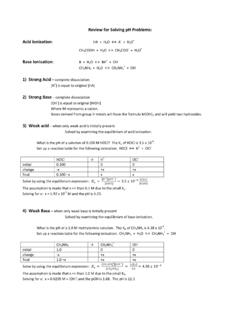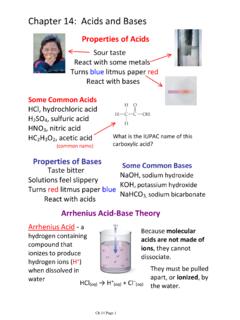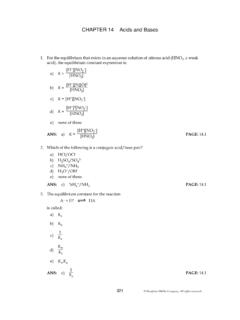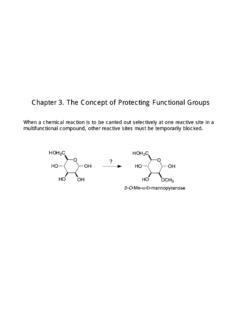Transcription of Chapter 14: Acids and Bases
1 Acids and Bases Know the definition of Arrhenius, Bronsted-Lowry, and Lewis acid and base . Autoionization of Water Since we will be dealing with aqueous acid and base solution, first we must examine the behavior of water. 1) In pure water, to which no electrolytes have been added, there is a small electrical conductivity, indicating that there are ions present. This is due to the autoionization of water. H2O(l) + H2O(l) OH-(aq) + H3O+(aq). OH- is the hydroxide ion. H3O+ is the hydronium ion The hydronium ion represents a proton that is hydrated by (surrounded by) water. There is never just a proton in solution. However, the hydronium ion is often represented by just a proton and the autoionization is written as a dissociation reaction. H2O(l) OH-(aq) + H+(aq). 2) This equilibrium can be described by an equilibrium expression: Keq = [H+][OH-]. This is given a special name and symbol.
2 Kw, the ion product of water. Experimentation shows that at a particular temperature, Kw is constant. At 25oC, Kw = 1 x 10-14. At 25o it will always be true that 1 x 10-14 = [H+][OH-]. 3) If water is the only source of protons, then [H+] = [OH-] = 1 x 10-7 and the solution is considered neutral. If [H+] > [OH-], then the solution is basic. If [H+] < [OH-], the the solution is acidic. Be able to write the equation for the autoionization of water. If given [H+] be able to calculate [OH-] and vice versa. The pH of aqueous solutions 1) Since the concentrations of [H+] and [OH-] observed are often very small, the p-scale is used to indicate the quantity present. p(X) = -log(X). We use this to determine pH, the pOH, pKa, and pKb values. Note: 1) There is an inverse relationship. For example, as [H+] increase, the pH decreases. 2) As the concentration changes by 10n, the pH will change by n.
3 For example if the concentration changes by a factor of 100 or 102, the pH will change by 2. 2) Applying the p scale to the equation for autoionization of water: Kw = [H+][OH-] = 1 x 10-14 results in pKw = pH + pOH = 14. If given [H+] or [OH-] be able to calculate pH and pOH. Behavior of Solutes in Water When a solute is added to water, a neutral, acidic, or basic solution will arise. The ultimate solution pH will depend on a reaction between the solute and water. 1) In the Bronsted-Lowry model, acid base behavior is shown as a transfer of a proton. 2) A Bronsted acid must contain H in the formula and the H must be easily removed. The general formula is HA. ex. H attached to highly electronegative atoms like the halogens, oxygen, or sulfur 3) A Bronsted base must contain a lone pair of electrons. The general formula is B. ex. O2-, OH-, F-, NH3 and other N derivatives 4) In the Bronsted-Lowry model, a reaction between an acid and a base occurs to form a new acid and a new base .
4 The Acids and Bases exist in pairs. When the acid loses a proton, it becomes a base and is called the conjugate base . When a base gains a proton, it becomes an acid and is called the conjugate acid . HA + B A- + BH+. ( acid ) ( base ) (conjugate) (conjugate). base acid 5) When an acid is added to water, there is a Bronsted-Lowry acid base reaction where the acid behaves as an acid , and water acts as the base . This is the acid ionization reaction. HA(aq) + H2O(l) A-(aq) + H3O+(aq). 6) When a base is added to water, there is a Bronsted-Lowry acid base reaction where the base behave as a base and water acts as the acid . This is the base ionization reaction. Be able to identify or provide the conjugate Acids and conjugate Bases of any acid or base . Remember, a conjugate base will have one less hydrogen than the acid and the conjugate acid will have one more hydrogen.
5 Keep your charges straight. Remember the hydrogen is removed as a proton. Categories of behavior of solutes in water what are the major species in water 1) If a solute has strong covalent bonds there is no reaction between solute and water. The pH will be unchanged when the solute dissolves. These are molecules with no H in the formula or contain an H that will not come off easily such as that found in methanol (CH3OH), ethanol (CH3CH2OH) or alkane chains such as butane (CH3CH2CH2CH3). 2) The solute is covalent and undergoes a reaction with water to produce a proton. a) There is a complete reaction with water when the solute is a strong acid (HClO4, H2SO4, HNO3, HI, HBr, HCl0) There will be no undissociated acid molecules left. The major species in solution after this reaction will be the conjugate base , H3O+, the anion, and H2O. HNO3(aq) + H2O(l) NO3-(aq) + H3O+(aq).
6 B) There is a partial reaction with water when the solute is a weak acid . Any acid that is not a strong acid is considered to be a weak acid . There will be an equilibrium and the major species in solution will be the weak acid and water. There will be small amounts of the conjugate base and the hydronium ion. HF(aq) + H2O(l) F-(aq) + H3O+(aq) ( acid ionization). 3) The solute is ionic. It will dissociate into ions and the component ions may undergo reaction with water. a) Strong Bases will dissociate to form OH-. Strong Bases are the hydroxides of Group I and Group II. metals. (NaOH and KOH are common strong Bases . LiOH, RbOH, and CsOH are less common strong Bases . Ca(OH)2, Ba(OH)2 and Sr(OH)2 will produce two moles OH- per mole of solid). These strong Bases will completely dissociate in water. The major species in water will be the metal ion, the hydroxide ion and water.
7 The reaction of interest is: OH-(aq) + H2O(l) H2O(l) + OH-(aq). Since there is no net change in the molecules present after the reaction, it is sufficient to know that the base dissociates in water. b) anion example: NaCN(aq) Na+(aq) + CN-(aq). Na+ + H2O no reaction CN- + H2O HCN + OH- ( base ionization). c) cation example CH3NH3Cl(aq) CH3NH3+(aq) + Cl-(aq). Cl-(aq) + H2O(l) no reaction CH3NH3+(aq) + H2O(l) CH3NH2(aq) + H3O+(aq) acid ionization Be able to write the chemical equations that show the acid base reaction of solutes in water. acid Ionization, Ka and pKa The acid ionization reaction is the transfer of a proton from the acid to water. HA(aq) + H2O(l) A-(aq) + H3O+(aq). The equilibrium expression for this reaction is Keq = [A-][H3O+]/[HA] = Ka For the acid ionization, Keq is written Ka and is called the acid dissociation constant. Ka values allow one to compare the strength of Acids .
8 Since it is an equilibrium constant, the larger the Ka, the more products there are, which means there will have been more dissociation of the acid and more protons formed. Thus, the larger the Ka, the stronger the acid . For strong Acids , the reaction lies so far to the right that [HA] is very small and it is difficult to determine the Ka accurately. However, comparing the values of weak Acids is very useful. The p notation can be employed, such that pKa = -log(Ka). Note that the larger the Ka, the smaller the pKa. Thus the stronger the acid , the smaller the pKa. Although we will discuss Bases more later, a comment can be made now on the relative strength of Bases . The relative strength of an acid is based on the extent to which it produces protons. The relative strength of a base depends on its affinity for a proton. The greater the affinity, the stronger the base .
9 In general, the stronger acid will produce a weaker conjugate base . Consider: HF(aq) + H2O(l) F-(aq) + H3O+(aq) Ka = x 10-4. CH3 COOH(aq) + H2O(l) CH3 COO- + H3O+ Ka = x 10-5. In the first reaction there is a competition between H2O and F- for the proton. In the second reaction there is a competition between H2O and CH3 COO- for the proton. The first reaction lies further to the right than the second reaction. Thus water can steal the proton from F- easier than from CH3 COO-. Thus, F- is the weaker base and HF is the stronger acid . The take home message the stronger the acid , the weaker the conjugate base or the weaker the base , the stronger the acid . Be able to calculate Ka from pKa and vice versa. Be able to rank the strength of Acids and conjugate Bases if given Ka or pKa information. Calculating the pH of Strong acid Solutions: In general, to determine the pH of a solution, the dominant equilibria must be identified.
10 Strong Acids dissociate completely. The major species in solution will be the proton and the conjugate base from the acid . What about the autoionization of water? This occurs to such a small extent that it can usually be ignored. Furthermore, the protons produced by the ionization of the strong acid will push the autoionization of water to the left because of Le Chatelier's principle. Thus, the major source of protons will be the acid . The concentration of protons will be equal to the concentration of the strong acid . What if two strong Acids are mixed together? Each acid will completely dissociate and the total [H+] will be a sum from both sources. What about the pH of a dilute concentration of a strong acid ? Be careful. If the acid is really dilute, such as 1 x 10-7 or less, the contribution of water will be important. You won't have to work any problems of this type, just be aware of this fact.















